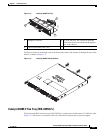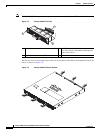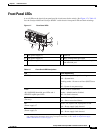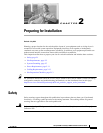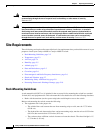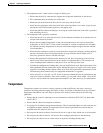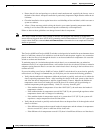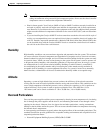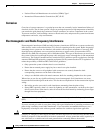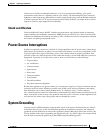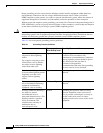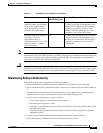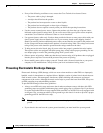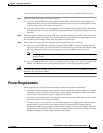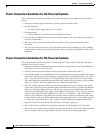
2-5
Catalyst 4948E and Catalyst 4948E-F Switch Installation Guide
OL-21561-02
Chapter 2 Preparing for Installation
Site Requirements
Note The 10°C temperature differential between the intake and the exhaust must be determined by
taking measurements using external digital temperature probes. Do not use the chassis internal
temperature sensors to measure the temperature differential.
• Plan for future growth. Your Catalyst 4948E or Catalyst 4948E-F switches currently installed in an
enclosed or partially enclosed rack might meet ambient air temperature and air flow requirements
now. However, if you add more chassis or other equipment to the rack, the additional heat generated
might cause the ambient air temperature within the rack to exceed 104°F (40°C) and can cause minor
alarms.
• If you are installing the Catalyst 4948E-F in a data center that uses the hot isle and cold isle style of
cooling, we recommend that you use an optional inlet air duct to extend the chassis air intake to the
cold isle. Panduit Corporation manufactures a Modular ToR Switch Inlet Duct (Model CDE2) that
can be installed along with the Catalyst
4948E-F chassis to extend the switch chassis air intake to
the cold isle at the front of the rack enclosure.
Humidity
High-humidity conditions can cause moisture migration and penetration into the system. This moisture
can cause corrosion of internal components and degradation of properties such as electrical resistance,
thermal conductivity, physical strength, and size. Extreme moisture buildup inside the system can result
in electrical shorts, which can cause serious damage to the system. Each system is rated to operate at 8
to 80 percent relative humidity, with a humidity gradation of 10 percent per hour. In storage, a system
can withstand from 5 to 95 percent relative humidity. Buildings in which climate is controlled by
air-conditioning in the warmer months and by heat during the colder months usually maintain an
acceptable level of humidity for system equipment. However, if a system is located in an unusually
humid location, a dehumidifier can be used to maintain the humidity within an acceptable range.
Altitude
Operating a system at high altitude (low pressure) reduces the efficiency of forced and convection
cooling and can result in electrical problems related to arcing and corona effects. This condition can also
cause sealed components with internal pressure, such as electrolytic capacitors, to fail or perform at
reduced efficiency. Each system is rated to operate at altitudes from –50 to 6500
feet (–16 to
1981
meters) and can be stored at altitudes of –50 to 35,000 feet (–16 to 10,668 meters).
Dust and Particulates
Fans cool the power supplies and the system components by drawing in room temperature air, circulating
the air through the power supplies and the chassis, and exhausting the heated air out through various
openings in the chassis. However, fans also ingest dust and other particulates, causing contaminant
buildup on the fan blades and in the system. This can create a thermal blanket on components increasing
the internal chassis temperature.
A clean operating environment can greatly reduce the negative effects of dust and other particulates. The
standards listed below provide guidelines for acceptable working environments and acceptable levels of
suspended particulate matter:
• Network Equipment Building Systems (NEBS) GR-63-CORE



